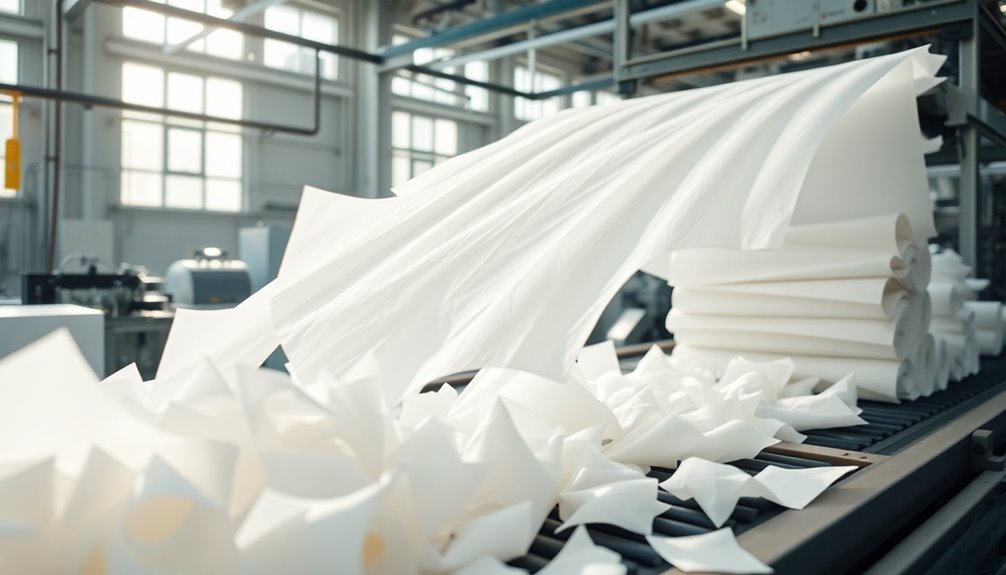Tissue paper's a lightweight, versatile product you'll find in many hygiene and household applications. It's made from recycled paper pulp, offering absorbency and softness that makes it perfect for toilet tissue, facial tissues, and wrapping. The production process guarantees high quality, complying with industry standards. You benefit from its slight transparency and comfort, which enhances its aesthetic appeal. As the market for tissue paper grows, so does the focus on eco-friendly options. If you're curious about its environmental impact or the innovative trends shaping the industry, there's plenty more to discover on this topic.
Key Takeaways
- Tissue paper is a lightweight, absorbent material made from recycled paper pulp, commonly used in hygiene and decorative applications.
- It originated in 2nd century BC China and became popular for personal hygiene with Joseph Gayetty's toilet tissue introduction in 1857.
- The production process involves sourcing cellulose fibers, draining water suspension, and rolling the paper, adhering to ISO standards.
- Tissue paper is critical for hygiene products, with consumer preferences for softness, strength, and hypoallergenic options for sensitive skin.
- The market is shifting towards sustainable practices, with increased demand for eco-friendly tissue products and innovations like the TAD process.
Definition of Tissue Paper

Understanding tissue paper starts with recognizing it as a lightweight, versatile product made primarily from recycled paper pulp. This lightweight paper type typically has a grammage ranging from 18 to 50 g/m² and a thickness between 10 to 35 g/m², making it slightly transparent.
You'll find that tissue paper plays a vital role in everyday life, serving various purposes, from hygiene products like toilet tissue and facial tissue to decorative uses in packaging and crafts.
The history of tissue paper dates back to the 2nd century BC in China, where it evolved from thick wrapping paper into the delicate products we use today. A significant milestone occurred in 1857 when Joseph Gayetty introduced the first commercially available toilet tissue, revolutionizing personal hygiene practices. This innovation marked a turning point in how people approached cleanliness and comfort.
Tissue paper's composition primarily includes cellulose pulp processed from wood fiber, allowing it to maintain its softness and absorbency.
In short, tissue paper is an indispensable product that combines practicality with historical significance, enhancing both hygiene and creativity in our daily lives.
Properties of Tissue Paper

Tissue paper boasts several distinct properties that make it unique and highly functional. As one of the lightest paper types available, its grammage typically ranges from 18 to 50 g/m², contributing to its softness and versatility. The thickness, usually between 10 to 35 micrometers, enhances its absorbency, making it perfect for a variety of uses.
Some key properties of tissue paper include:
- Absorbency: Its structure allows for quick moisture absorption, ideal for products like facial tissues and paper towels.
- Lightweight: Being a lightweight paper type, it's easy to handle and transport, making it suitable for various applications, including wrapping delicate items.
- Transparency: Slightly transparent due to its thinness, tissue paper provides an aesthetic appeal while protecting contents.
Made primarily from cellulose pulp processed from wood fiber, tissue paper has a smooth texture that adds to its comfort and functionality.
These properties guarantee that tissue paper remains a staple in both hygiene and packaging industries, meeting specific needs without compromising on quality.
Production Process

The production process of tissue paper involves a series of precise steps that transform cellulose pulp into a lightweight, absorbent product.
First, manufacturers source cellulose pulp, which can be derived from wood fibers or recycled materials. This guarantees the final product remains both eco-friendly and efficient.
Next, the cellulose fibers are drained from a water suspension. This wet pulp is then rolled onto specialized machines, allowing you to achieve the desired thickness. The thickness of tissue paper is typically measured in Grams per Square Meter (GSM), with standard tissue paper ranging between 10 to 35 GSM.
Once rolled, the tissue moves on to steam-heated sections where it's dried to remove excess moisture.
After drying, it's transferred onto large cylinders for cutting, ensuring each piece is the right size for consumers.
Throughout this entire production process, advanced manufacturing techniques and high-tech machinery play a vital role in maintaining the quality and consistency of tissue paper, resulting in a product that's not just lightweight but also highly absorbent.
Main Applications

From personal hygiene to stylish packaging, tissue paper serves a multitude of essential applications in everyday life. You likely rely on various tissue paper products without even thinking about it.
For instance, bathroom tissue, paper towels, and facial tissues are fundamental for maintaining improved hygiene and cleanliness. In fact, many people in Western Europe use around 200 facial tissues each year, underscoring their significance in infection control.
Tissue paper also shines in the fashion industry. It's commonly used as wrapping tissue for delicate clothing items, helping to protect them during transport while elevating the presentation of luxury goods. Additionally, it plays an important role in packaging fragile items, particularly in sectors like wine, preventing damage during shipping and handling.
Here's a quick look at some main applications of tissue paper:
- Personal hygiene: Essential for everyday cleanliness.
- Wrapping tissue: Protects delicate items during transport.
- Decorative applications: Enhances gift wrapping and craft projects.
With its versatility, tissue paper truly enriches our daily lives in both practical and aesthetic ways.
Specialized Uses

Versatile and often overlooked, tissue paper finds specialized applications that enhance various industries. In the packing industry, it plays an essential role by safeguarding fragile items during shipping and handling. Its lightweight nature helps reduce the risk of damage, ensuring that your precious goods arrive in pristine condition.
Additionally, tissue paper serves as acoustic disrupters in sound engineering. You'll find it dampening sound vibrations, which greatly improves audio quality in various applications, from recording studios to home theaters.
In road repair, tissue paper protects crack sealants, preventing debris from contaminating the sealant and ensuring its durability for longer-lasting repairs.
Not only does tissue paper excel in these practical uses, but it also shines in the world of creativity. When it comes to origami, its flexibility and lightness allow you to craft intricate folds and detailed designs with ease.
Finally, the fashion industry relies on tissue paper as a protective layer for delicate clothing items, keeping them safe from creases and damage during storage and transport.
Environmental Impact

When you consider the environmental impact of tissue paper, deforestation is a major concern, with countless trees lost daily to production.
However, the industry is shifting towards using more recycled fibers, which can help mitigate these effects.
Initiatives like eco-labeling also encourage sustainable practices, making it easier for you to choose products that are kinder to the planet.
Deforestation Concerns
The production of tissue paper has significant deforestation concerns that shouldn't be overlooked. The paper industry is heavily linked to global deforestation, with an astounding 270,000 trees being flushed down toilets daily due to toilet paper use. This not only destroys crucial ecosystems but also contributes to biodiversity loss and climate change.
To truly understand the impact, consider these key points:
- A large portion of tissue products relies on virgin wood fiber, increasing the risk of deforestation.
- Sustainable forestry initiatives aim to source materials responsibly, yet many companies still fall short.
- About 46.5% of raw materials in the paper industry come from recycled paper, showcasing a shift towards more eco-friendly practices.
While some organizations, like the European Tissue Symposium, advocate for reduced CO2 emissions and better forest management, the environmental footprint of tissue paper remains concerning.
Advocating for sustainable sourcing and supporting products from certified mills can help mitigate these issues. As consumers, you can play a crucial role in demanding change and supporting practices that protect our forests and environment for future generations.
Recycled Fiber Usage
Utilizing recycled fibers in tissue paper production plays a crucial role in reducing environmental impact. By incorporating approximately 46.5% of recovered fibers, the paper industry effectively mitigates deforestation and conserves natural resources.
This shift towards recycled fibers not only promotes sustainability but also helps decrease carbon emissions associated with the use of virgin wood fibers.
When you choose tissue products made from recycled paper pulp, you support a more environmentally friendly option. Life-cycle assessments show that these products have a lower overall environmental footprint compared to those made from virgin fibers.
The European Tissue Symposium advocates for these sustainable practices, encouraging manufacturers to increase the use of recycled fibers and solidify the industry's commitment to environmental responsibility.
Eco-labeling Initiatives
Eco-labeling initiatives play an essential role in guiding consumers toward sustainable choices in the tissue paper market. Programs like the German Blue Angel, which started in the late 1970s, focus on promoting products that meet specific environmental criteria.
By choosing eco-labeled tissue paper, you can make a positive impact on the environment.
Here are a few benefits of supporting eco-labeled products:
- Trustworthy Standards: Type I eco-labels are set by third parties, ensuring that the products you choose have undergone rigorous assessments.
- Resource Efficiency: Approximately 46.5% of the raw materials used in the paper industry come from recovered fibers, considerably reducing the need for virgin pulp.
- Promoting Conservation: Organizations like the European Tissue Symposium actively advocate for sustainable practices, helping to safeguard our forests and lower carbon emissions.
Market Trends

There's no denying that the tissue paper market is evolving rapidly, with considerable growth projected in various regions. In China, the global tissue market is expected to expand at rates of 8-9%, while Europe sees a more modest growth of 2-3%. As disposable incomes rise and urbanization increases, your demand for tissue products will only intensify.
North America, which consumes about three times more tissue products than Europe, remains a powerhouse in this sector, contributing to a total global production of 21 million tonnes.
The European tissue market, valued at around 10 billion Euros, accounts for about 10% of the total paper and board market and is experiencing an annual growth rate of approximately 3%. The COVID-19 pandemic has also shifted market dynamics, considerably increasing the demand for hygiene products and impacting the away-from-home (AfH) segment.
Additionally, notable market trends include a shift towards using recovered fibers in tissue manufacturing, driven by eco-labeling initiatives like the German Blue Angel program, which started in the late 1970s. This trend not only promotes sustainability but also aligns with consumers' growing environmental awareness.
Industry Standards

When you consider the tissue paper industry, understanding the definition of a ream and the ISO regulations is essential.
These standards help guarantee that products meet quality control measures, so you can trust what you buy.
Ream Definition Standards
A ream of tissue paper is standardized to consist of 480 sheets, a regulation set by the International Organisation for Standardisation (ISO) in the UK. This standardisation guarantees you receive a consistent quantity and quality whenever you purchase tissue paper.
Knowing what a ream contains helps you understand how much product you're getting, which is essential for both personal and commercial use.
Here are a few key points about reams of tissue paper:
- Each ream typically weighs about the same as three 1-liter bottles of water, giving you a practical weight reference.
- Tissue paper thickness is measured in Grams per Square Meter (GSM), with common values ranging from 10 to 35 GSM, emphasizing its lightweight nature.
- The GSM classification helps distinguish tissue paper from other paper types, as office printer paper usually falls between 70 to 100 GSM.
Understanding these ream definition standards is important for making informed choices about your tissue paper needs.
Whether you're stocking up for home use or a business, knowing these details enhances your shopping experience and guarantees you get the right product.
ISO Regulations Overview
How do ISO regulations impact the tissue paper industry? They play a significant role in establishing consistent standards for manufacturers and retailers alike. For instance, ISO (International) regulations define a "ream of tissue paper" as consisting of 480 sheets, ensuring uniform size and quality. This consistency helps build consumer trust and promotes fair retail practices across the products industry.
Moreover, ISO standards dictate how tissue paper is measured, particularly regarding Grams per Square Metre (GSM). Typically, tissue paper falls within a range of 10 to 35 GSM, which aids manufacturers in producing items that meet consumer expectations. Compliance with these regulations is essential for manufacturers, as it directly impacts safety, environmental considerations, and overall product quality.
The emphasis on quality control within ISO standards enhances the reliability and performance of tissue products, allowing consumers to make informed choices.
As a result, when you purchase tissue paper, you can feel confident knowing that it adheres to strict industry benchmarks, thanks to the rigorous guidelines set forth by ISO.
Quality Control Measures
Quality control measures in the tissue paper industry are essential for guaranteeing that products not only meet but exceed consumer expectations. These measures help maintain high standards in a market where tissue paper is lightweight and used in various applications. Manufacturers and retailers follow strict protocols, guided by ISO standards, to guarantee consistency.
Key aspects of quality control include:
- Testing absorbency to guarantee effective use in hygiene products.
- Assessing strength and durability to withstand everyday use.
- Monitoring GSM (Grams per Square Meter) to determine thickness, typically ranging from 10 to 35 GSM.
Approximately 60% of pulp and paper is sourced from certified mills, enhancing environmental credibility. Organizations like the European Tissue Symposium (ETS) play a pivotal role in establishing best practices and promoting sustainable production methods.
Innovations and Future Trends

Innovation drives the future of tissue paper, with manufacturers constantly exploring new technologies to enhance product performance. One notable advancement is the TAD (Through-Air-Dried) process, which boosts absorbency and strength, even if it's more energy-intensive.
You'll notice that the industry is increasingly leaning towards sustainability, with about 46.5% of raw materials sourced from recycled content. This shift not only reduces reliance on virgin pulp but also aligns with eco-labeling initiatives like the German Blue Angel program, encouraging environmentally friendly practices.
As consumer awareness of environmental issues grows, ongoing research and collaboration are essential. Manufacturers are working on sustainable products, such as acid-free tissue paper, which protects sensitive items while addressing eco-concerns.
Additionally, the global tissue market is projected to grow at rates of 8-9% in emerging markets like China. This trend highlights the rising demand for hygiene products, driven by urbanization and increasing disposable incomes.
In this evolving landscape, you can expect continued innovations that prioritize absorbency, sustainability, and eco-labeling, ensuring that tissue paper meets both consumer needs and environmental standards.
Frequently Asked Questions
What Is Tissue Paper Used For?
Tissue paper's used for a variety of purposes. You might use it for hygiene products like toilet paper and paper towels, or to clean up spills in the kitchen.
It's also great for wrapping delicate items, enhancing presentations, and preventing damage during shipping. You can even find it in artistic applications or as packing material.
Plus, its customizable colors and textures make it perfect for adding a personal touch to gifts or branding.
Is Tissue Paper and Toilet Paper the Same Thing?
No, tissue paper and toilet paper aren't the same thing.
While both are made from similar materials, they serve different purposes. Toilet paper is specifically designed for personal hygiene and is thicker and softer for comfort.
Tissue paper, on the other hand, includes a variety of products like facial tissues and wrapping paper, with different thicknesses and absorbencies based on their intended use.
What Is Tissue Paper Called in Us?
In the U.S., you'll often hear tissue paper referred to simply as "tissue" or "tissue paper."
This term covers a variety of products, including facial tissues, toilet tissue, paper towels, and napkins. Each type serves a specific purpose, from personal hygiene to cleaning.
When you're shopping or using these products, just remember that "tissue" can encompass all these different forms of paper, depending on the context.
What Is an Example of Tissue Paper?
An example of tissue paper you might use every day is facial tissue. It's soft, disposable, and perfect for hygiene needs like wiping your nose or removing makeup.
You probably find a box of these handy in your home or office.
Another common type is paper towels, which are great for cleaning up spills due to their absorbency.
Both serve practical purposes while offering convenience and comfort in daily life.
Conclusion
To summarize, tissue paper is a versatile product with a wide range of applications, from everyday use to specialized functions. Understanding its properties and production process helps you appreciate its role in daily life. As you consider its environmental impact, keep an eye on market trends and innovations shaping the future of tissue paper. By choosing eco-friendly options, you can contribute to a more sustainable industry while enjoying the convenience tissue paper offers.










